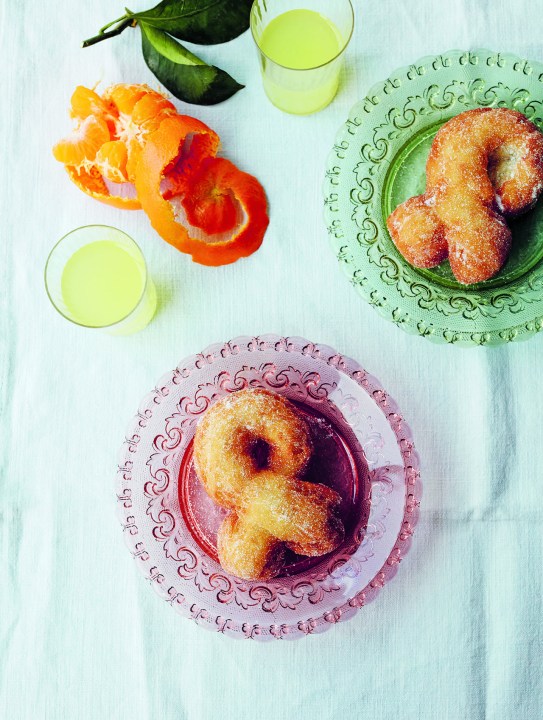(NEXSTAR) – The ball is dropping, the champagne is popping, and Guiseppe Dell’Anno is in the kitchen frying up doughnuts.
Dell’Anno, the winner of the 12th series of “The Great British Baking Show,” is undoubtedly a skilled baker, having been awarded “Star Baker” twice during his season and earning just as many handshakes from Paul Hollywood. He’s adept at all manner of cakes, cookies and tarts, but he’s sticking with tradition on New Year’s Eve, and making a sweet treat he grew up eating at his grandparents’ house during the holidays.
“Proper celebration of New Year’s Eve in the Dell’Anno household must include the traditional ciambelle: these are deep fried, sugar-coated, doughnut-like treats,” explains Dell’Anno, who shares his recipe — along with dozens of others — in his new cookbook “Giuseppe’s Italian Bakes.”
Ciambelle, he says, are also especially “cloud-like” in texture thanks to the addition of mashed potato to the dough.
“They are unbeatable as a treat to be offered to visitors and friends on the last night of the year, possibly with a glass of chilled Prosecco or Spumante,” he tells Nexstar.
Hoping to recreate Dell’Anno’s doughnuts at home? Check out the recipe below, or follow Dell’Anno on social media for other entertaining ideas.

Ciambelle di Patate (Potato Doughnuts)
Makes about 20
• 10½ ounces (300 grams) floury potatoes, such as Maris Piper (about 2 medium potatoes)
• 3½ tablespoons (50 grams) unsalted butter
• 2¼ cups (300 grams) plain (all-purpose) flour, plus extra for dusting
• 2 teaspoons dry yeast
• ¼ cup (60 grams) whole milk
• 1 medium egg (50 grams)
• 2 tablespoons caster (superfine) sugar, plus 1 extra cup for coating
• Zest of 1 organic lemon
• 1/8 teaspoon salt
• Sunflower or corn oil, for frying
1. Place the potatoes in a medium saucepan, cover them with boiling water and simmer until thoroughly cooked. The timing depends on the size, type and freshness of the potatoes, but it is likely to be about 30 minutes. The potatoes are cooked when you can comfortably push a fork through their thickest section.
2. Meanwhile, weigh the butter in a microwave safe bowl and microwave it for 30–40 seconds to melt it completely. Stir to make sure that there are no solid lumps left and set aside.
3. When the potatoes are cooked, drain the hot water and fill the pan with cold water. When they are cool enough to handle, peel them, place them in a large bowl and mash them carefully: The flesh must be reduced into a smooth pulp. Pour the butter over the mashed potatoes immediately and mix to combine. Do not leave the mashed potatoes to rest uncovered as they will dry out and create flecks that will be difficult to dissolve in the dough. Add the flour, yeast, milk, egg, 2 tablespoons of sugar, lemon zest and salt, and mix with your hand to combine.
4. When the dough comes together in a coherent mass, turn it on to the worktop and knead it for 1–2 minutes until smooth. The dough should feel soft, and ever so slightly sticky, but not wet. If necessary, add a minimal dusting of flour. Shape the dough into a ball and drop it back in the bowl. Leave it to prove away from cold drafts and direct sunlight until doubled in volume. It should take about 45–50 minutes at 68 degrees F (20 degrees C).
5. While the dough is proving, lay a large, clean dish towel over the worktop and dust it generously with flour. Also lightly flour an area of the worktop ready for shaping the dough.
6. Transfer the proved dough to the floured worktop and divide it into 4 pieces. Work on one piece at a time and progressively roll it into a noodle 1 centimeter (½-inch) thick. Cut 20-centimeter (8-inch) lengths, then fold each length to form the characteristic looped shape, pinching the dough to join the ends of the loop where they overlap. Each ciambella will be about 1¼ ounces (35 grams). Arrange the loops over the floured dish towel as you shape the remaining dough. Cover the loops of dough with a second, clean dish towel and leave them to prove until they look light and slightly swollen. This should take 45–50 minutes at 20°C (68°F). Be careful not to overprove the dough at this stage or the ciambelle might deflate once fried.
7. Meanwhile, set the oil temperature in a fryer to 350 F (180 C) or find a pan large enough to comfortably fit at least 3 loops of dough. Fill the pan with at least 3¼–4 inches (8–10 centimeters) of oil and place it over a medium heat, controlling the temperature with a cooking thermometer. While the oil heats up, line a cooling rack with 2 layers of kitchen paper, and place it next to the fryer. Place a cup of caster sugar in a medium bowl to coat the ciambelle.
8. Fry 2–3 ciambelle at a time for about 2 minutes, turning them over a couple of times with a slotted spoon to cook them evenly. They are ready when the skin looks a light caramel color. Rest the fried ciambelle over the kitchen paper to drain any excess oil.
9. When the ciambelle are cool enough to handle but still warm, toss them in the bowl with the caster sugar to coat them evenly and then move them to a serving plate. Store in an airtight container for up to 2 days.
Note: The milk in this recipe can be swapped for a liqueur of your choice (Dell’Anno suggests limoncello or amaretto) to give the ciambelle a stronger flavor.






